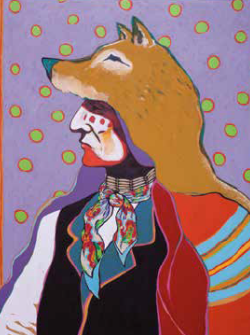 The concept of American identity often conjures images of thick-skinned explorers and triumphant western expansion. Indeed, Gilcrease Museum is known for world-class American western art celebrating names like Thomas Moran and Frederic Remington. But this collection also contains a more nuanced story, wherein the ideology of manifest destiny throughout the American continents is stained by the reality of tragedy and dispossession.
The concept of American identity often conjures images of thick-skinned explorers and triumphant western expansion. Indeed, Gilcrease Museum is known for world-class American western art celebrating names like Thomas Moran and Frederic Remington. But this collection also contains a more nuanced story, wherein the ideology of manifest destiny throughout the American continents is stained by the reality of tragedy and dispossession.
Honoring the vision of Thomas Gilcrease, the museum conveys the true and messy narrative of cowboys, transcontinental settlers and Indigenous cultures while cultivating an in-depth conversation and reevaluation of American history. Currently, Gilcrease is going a step further with a new interpretive master plan. The goal is to inspire visitors to acknowledge the continually changing definition of American identity and invite them to engage in their own communities through artistic, social and cultural discourse and action. Gilcrease’s Executive Director Susan Neal hopes visitors will be surprised by the changes. “They will see works that maybe to them look out of place. Putting contemporary native pottery in front of Thomas Moran’s ‘Shoshone Falls on the Snake River’ creates a conversation within the gallery predicated on the question, ‘What is a master work?’”
Americans All!
Through the lens of an immigrant, the exhibition Americans All! combines art from the Gilcrease collection and contemporary works from immigrants in the Tulsa community. The title Americans All! revives a phrase used in World War I to entice immigrants to join the service. Despite being foreign-born, the United States considered them to be part of the red, white and blue.
For this show, Curator of History Mark Dolph orchestrated a conversation among the featured artworks. Dolph explained, “We have the work ‘Westward the Course of Empire Takes Its Way’ by German-born Emanuel Leutze, that considers one perspective of 19th century expansion positioned next to ‘A Disputed Passage’ by Jules Tavernier, who immigrated to America from France. Where Leutze’s work proclaims that manifest destiny was indeed the
nation’s ‘obvious future,’ Tavernier paints a much more ambiguous picture, one where nature and the agency of Native people have a role to play.”
In the same exhibition, a video performance by a young Mexican Deferred Action for Childhood Arrivals recipient and art student Carmen Castorena depicts her desire to appear American. “The Perfect Tommy Girl” shows Castorena at her bathroom mirror trying to become more American with makeup, dying her black hair blonde, changing the color of her eyes to blue and bleaching her skin to appear whiter. Dolph believes her message is transcendent: “I think so many of our guests relate to Carmen because she speaks to the very human longing to be accepted.”
By pairing the museum’s historical collection of works with those of contemporary artists from Cuba, Japan, Lebanon and Mexico, Americans All! provides refreshing insight into being American. Senior Curator and Curator of Art Laura Fry pointed out, “Many artists who we consider to be quintessentially American were born in other countries. Immigrants have been a part of shaping who we are as Americans.”
Blake Little: Photographs from the Gay Rodeo
Despite his popular culture reputation, John Wayne is not a traditional cowboy. “Cowboys were historically multiracial from all different walks of life and commonly Native American,” Fry said. In a recent Gilcrease exhibition, photographer Blake Little provided a new interpretation of cowboys and masculinity by inviting viewers to the gay rodeo.
In the 1980s, the gay rodeo was founded for cowboys who grew up in rural areas and were interested in rodeo sports, but who because of their sexual orientation, were not welcomed at traditional rodeos. Shot at the height of the AIDS epidemic when the gay community was ravaged by disease and death, Little’s photos are full of hope, life and fellowship. “The gay rodeo was a place where these cowboys could celebrate being westerners, bull
riders and the fact that they were gay,” Fry said. “They could celebrate their full identity versus having to ignore or suppress part of their identity.”
Along with Little’s photos, Gilcrease collaborated with Tulsa’s Oklahomans for Equality to host: OutWest with OKEQ. It was a celebration of the west’s long but often forgotten LBGTQ+ history, featuring a night of country-western music and dancing.
Albert Bierstadt: Witness to a Changing West
Albert Bierstadt is known as one of America’s premier western landscape artists, and his focus on preserving instead of exploiting the environment and Native peoples is groundbreaking. Through his paint brush, he unearths the untold story of the early wildlife conservation movement. “He shifted the way we see the environment around us,” Fry said. Bierstadt serves as a reminder that the value of land is not only summed up by farming and ranching purposes but also its majestic beauty.
Gilcrease in the 21st Century
Gilcrease invites the Tulsa community to experience new and culturally-varied exhibitions like Bob Dylan: Face Value and Beyond or Pulitzer Prize Photographs where through the eyes of the photographer, visitors reshape their understanding of history. Often recalling memories of where they were during a specific historic moment, the photos encourage viewers to bring their own stories to the conversation.
America continues to be more diverse in cultures, opinions and stories. “If we are reflective of the American experience, we need to be responsive as it changes,” Senior Director of Development Frank Mulhern said. “The common language is the art that they create.”